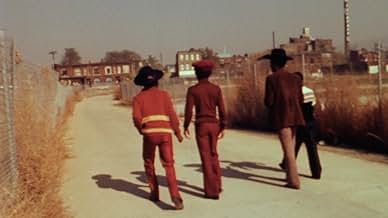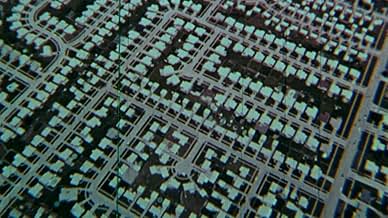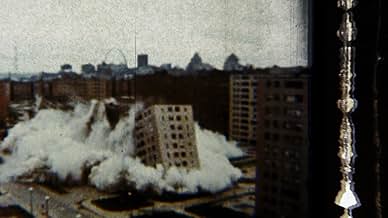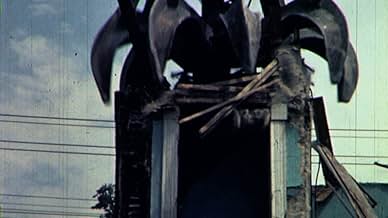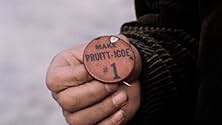2011 "The Pruitt-Igoe Myth" explores the rise & fall of titular housing complex in St. Louis, examining racism & gov. Policies through interviews with former residents & historical footage. ... Read all2011 "The Pruitt-Igoe Myth" explores the rise & fall of titular housing complex in St. Louis, examining racism & gov. Policies through interviews with former residents & historical footage. Ft racism, urban poverty & inequality in America.2011 "The Pruitt-Igoe Myth" explores the rise & fall of titular housing complex in St. Louis, examining racism & gov. Policies through interviews with former residents & historical footage. Ft racism, urban poverty & inequality in America.
- Director
- Writers
- Stars
- Awards
- 2 wins & 2 nominations total
Irvin Dagen
- Self - St. Louis Housing Authority
- (archive footage)
Elmer Fiedler
- Self - Black Jack Baptist Church
- (archive footage)
- (as Rev. Elmer Fiedler)
Robert Schuchardt
- Self - Zoning Commission Chairman
- (archive footage)
- (as Dr. Robert Schuchardt)
- Director
- Writers
- All cast & crew
- Production, box office & more at IMDbPro
Featured reviews
The movie includes fascinating archival footage and interviews with five former residents of the public housing development. Some of these residents talked about the joyful experiences they had there, while others told harrowing stories. One of the most interesting things was listening to why they moved to the project initially. They told of how exciting it was to get into a modern development.
The movie also suggests some causes for the decline of the project, such as population loss in St. Louis, lack of funding for maintenance, and the loss of manufacturing jobs to the suburbs. When I discussed the movie with friends afterwards, we remained unsure in our speculation about the true causes.
The movie also suggests some causes for the decline of the project, such as population loss in St. Louis, lack of funding for maintenance, and the loss of manufacturing jobs to the suburbs. When I discussed the movie with friends afterwards, we remained unsure in our speculation about the true causes.
The Pruitt-Igoe Myth is a documentary that tries to zero in on just why the massive public project went so quickly from being an modern masterpiece to an absolute hell in such a short amount of time. Architects, urban planers, sociologist, and politicians have all weighed in on why the housing project failed, but no one can pin point the exact problem. This documentary aims to step back from the project and look at the city of St. Louis as a whole. Urban Flight and the lack of jobs and support from the city are pointed to instead.
The Pruitt-Igoe Myth means well. All too often, the reason for the project's demise is pointed to the poor that lived that. That they couldn't have nice things and keep up with them. The documentary, however, gives those people a voice. Throughout the film, people who lived in the community speak highly of their time there during what seemed to be golden years. Stories of love, union, and community run rampant. But that almost comes to the film's fault. We know whose side the film makers are on. And we only get the human story and not the other things that lead to the end. We aren't told about the skip-stop elevators, the condensing of physical space, or the fight for mixed housing. We hear a majority of human stories.
Luckily, the interviewees paint a terrific and chilling picture of their experiences in the community. Even years later, a woman is brought to tears recounting how the people of the projects were viewed. Also a bonus are the massive amounts of pictures and videos looking back to a time we've all forgotten.
The Pruitt-Igoe Myth is a great documentary that feels incomplete. Like having pancakes without bacon and eggs, what you get out of the movie is delicious...but you feel like you're missing something.
The Pruitt-Igoe Myth means well. All too often, the reason for the project's demise is pointed to the poor that lived that. That they couldn't have nice things and keep up with them. The documentary, however, gives those people a voice. Throughout the film, people who lived in the community speak highly of their time there during what seemed to be golden years. Stories of love, union, and community run rampant. But that almost comes to the film's fault. We know whose side the film makers are on. And we only get the human story and not the other things that lead to the end. We aren't told about the skip-stop elevators, the condensing of physical space, or the fight for mixed housing. We hear a majority of human stories.
Luckily, the interviewees paint a terrific and chilling picture of their experiences in the community. Even years later, a woman is brought to tears recounting how the people of the projects were viewed. Also a bonus are the massive amounts of pictures and videos looking back to a time we've all forgotten.
The Pruitt-Igoe Myth is a great documentary that feels incomplete. Like having pancakes without bacon and eggs, what you get out of the movie is delicious...but you feel like you're missing something.
The Pruitt-Igoe housing development in St. Louis is the focus of this film, but it could have just as soon been Cabrini-Green in Chicago or any one of a number of similar projects across the American big cities. It's an exploration as to why these huge public housing projects became hellish instead of the paradises they were originally envisioned. Fortunately, the filmmakers don't pick any one or two simple answers but talk about the multitude of issues that led to the projects failing...and ultimately being demolished. Among the problems discussed in the film were the lack of jobs as businesses and middle classes migrated to the suburbs, the increase of violence and vandalism, lack of maintenance, segregation as well as the insane notion that in order to get public assistance that fathers could not remain in the home!
This documentary is depressing and few folks would enjoy watching it. Now I am NOT saying it's bad and it's good for folks to become familiar with the issues that come up in the film. But it's just not the sort of thing most people would choose to watch and is probably more a film that educators might show to sociology or other such classes in order to explain the failures of these programs. Interesting and well made...despite it being such a terrible story.
This documentary is depressing and few folks would enjoy watching it. Now I am NOT saying it's bad and it's good for folks to become familiar with the issues that come up in the film. But it's just not the sort of thing most people would choose to watch and is probably more a film that educators might show to sociology or other such classes in order to explain the failures of these programs. Interesting and well made...despite it being such a terrible story.
The Pruitt-Igoe Myth attempts to dispel some of the myths about that infamous housing complex in St. Louis. In particular it targets the inaccurate public perception of why government housing projects fail, while at the same time taking into account how the residents themselves felt about what they called home. In order to tackle the complexity of the issue, the documentary is structured in a chronological way, starting in the 1940's and concluding at the destruction of the complex in the 1970's.
Pruitt-Igoe was commissioned to battle the lack of competent housing in St. Louis. To give a bit of background, St. Louis was a bustling industrial city for the first half of the 20th century. After a slump during the Great Depression, expectations were high for the growth of the city. The documentary emphasizes this idea of growth. It claims there was a culture of growth in St. Louis, with huge expectations of economic activity and population increases. Pruitt-Igoe was commissioned and built within this culture of growth. It was envisioned to replace the tenements that housed tens of thousands of poor residents throughout the city, and concentrate them within 33 high-rises on a large piece of urban land.
There was great faith in Pruitt-Igoe. It was essentially supposed to be a solve-all. By adding competent housing into the equation, planners thought that these poor people would have a solid base to move up the socio-economic ladder, since the expectation was that jobs would be available. However, no one was able to envision the terror that was to strike St. Louis; the growth that was expected within the city did not happen.
What occurred instead was the de-industrialization of the city. Though the causes of this de-industrialization are debatable, the documentary attributes it to a phenomenon called suburban sprawl. This storyline is not particular to St. Louis however, and similar effects were seen across the nation.
The new level of post-war prosperity allowed millions of whites across the nation to afford green lawns and quiet communities in newly built sub-divisions. Industries followed these blue-collar workers, and cities were devastated. St. Louis lost 20% of its population by 1970. Cities like Detroit and Cleveland lost closer to a third. The tax bases of these cities were destroyed. Pruitt-Igoe was built with federal funds but maintained by rent income and local taxes. When the money dried up, which it did right away, the complex was left on its own. The residents blamed the Housing Authority, the Housing Authority blamed the city of St. Louis, St. Louis blamed the federal government, and the documentary blames white-flight. So why exactly did whites move? Some, including myself, would argue it was simple economics, because cheaper land was available outside city limits and the automobile made it possible to live in the suburbs and commute to work. The emerging middle class no longer had to live near industrial zones. However, the documentary contends that it was racially based. One white middle aged woman, when asked why she moved to the suburbs, replied "because I wanted to live in a white community." She went on to say that though she did not believe blacks should be oppressed, she could not live next to them. Another white woman interviewed expressed her fear of plummeting property values and crime when blacks moved into adjacent neighborhoods. No doubt the makers of The Pruitt-Igoe Myth included these interviews to advance the claim that Pruitt-Igoe failed due to racism. Yet this opinion seems to be on the fringe of moderate consensus, because where one chooses to live does not directly affect the life of another. Blacks were just as poor when whites lived in the city. The only difference was that in the case of Pruitt-Igoe, they were living in un-maintained high-rises built by whites. The failure of Pruitt-Igoe actually resulted from the ignorance of planners who did not consider the longevity of a place filled with the poorest of the poor. There was no way that these people would be able to maintain the buildings without federal aid. The city of St. Louis, faced with a plummeting population and tax base, could not do so either. The thesis of the documentary is that the failure of Pruitt-Igoe, though a disaster in itself, does not reflect disaster in every federally funded housing project. Though the cause of defending federal housing projects is admirable, the documentary makes the too-obvious argument that Pruitt-Igoe failed due to white-negligence. This sort of finger pointing does nothing to advance the situation of blacks. Nor does it take into account the very racist and segregationist nature of America in the first place. The majority of white Americans, both before and after Pruitt-Igoe, preferred to live in white communities. This is a trend that we still see to this day. So as long as planners huddle poor people into certain areas and expect something magical to happen, basic economics will reign supreme and these people will remain poor.
Pruitt-Igoe was commissioned to battle the lack of competent housing in St. Louis. To give a bit of background, St. Louis was a bustling industrial city for the first half of the 20th century. After a slump during the Great Depression, expectations were high for the growth of the city. The documentary emphasizes this idea of growth. It claims there was a culture of growth in St. Louis, with huge expectations of economic activity and population increases. Pruitt-Igoe was commissioned and built within this culture of growth. It was envisioned to replace the tenements that housed tens of thousands of poor residents throughout the city, and concentrate them within 33 high-rises on a large piece of urban land.
There was great faith in Pruitt-Igoe. It was essentially supposed to be a solve-all. By adding competent housing into the equation, planners thought that these poor people would have a solid base to move up the socio-economic ladder, since the expectation was that jobs would be available. However, no one was able to envision the terror that was to strike St. Louis; the growth that was expected within the city did not happen.
What occurred instead was the de-industrialization of the city. Though the causes of this de-industrialization are debatable, the documentary attributes it to a phenomenon called suburban sprawl. This storyline is not particular to St. Louis however, and similar effects were seen across the nation.
The new level of post-war prosperity allowed millions of whites across the nation to afford green lawns and quiet communities in newly built sub-divisions. Industries followed these blue-collar workers, and cities were devastated. St. Louis lost 20% of its population by 1970. Cities like Detroit and Cleveland lost closer to a third. The tax bases of these cities were destroyed. Pruitt-Igoe was built with federal funds but maintained by rent income and local taxes. When the money dried up, which it did right away, the complex was left on its own. The residents blamed the Housing Authority, the Housing Authority blamed the city of St. Louis, St. Louis blamed the federal government, and the documentary blames white-flight. So why exactly did whites move? Some, including myself, would argue it was simple economics, because cheaper land was available outside city limits and the automobile made it possible to live in the suburbs and commute to work. The emerging middle class no longer had to live near industrial zones. However, the documentary contends that it was racially based. One white middle aged woman, when asked why she moved to the suburbs, replied "because I wanted to live in a white community." She went on to say that though she did not believe blacks should be oppressed, she could not live next to them. Another white woman interviewed expressed her fear of plummeting property values and crime when blacks moved into adjacent neighborhoods. No doubt the makers of The Pruitt-Igoe Myth included these interviews to advance the claim that Pruitt-Igoe failed due to racism. Yet this opinion seems to be on the fringe of moderate consensus, because where one chooses to live does not directly affect the life of another. Blacks were just as poor when whites lived in the city. The only difference was that in the case of Pruitt-Igoe, they were living in un-maintained high-rises built by whites. The failure of Pruitt-Igoe actually resulted from the ignorance of planners who did not consider the longevity of a place filled with the poorest of the poor. There was no way that these people would be able to maintain the buildings without federal aid. The city of St. Louis, faced with a plummeting population and tax base, could not do so either. The thesis of the documentary is that the failure of Pruitt-Igoe, though a disaster in itself, does not reflect disaster in every federally funded housing project. Though the cause of defending federal housing projects is admirable, the documentary makes the too-obvious argument that Pruitt-Igoe failed due to white-negligence. This sort of finger pointing does nothing to advance the situation of blacks. Nor does it take into account the very racist and segregationist nature of America in the first place. The majority of white Americans, both before and after Pruitt-Igoe, preferred to live in white communities. This is a trend that we still see to this day. So as long as planners huddle poor people into certain areas and expect something magical to happen, basic economics will reign supreme and these people will remain poor.
I watched this last night for the first time and afterwords I just wanted to find a government employee and slap them. I have always been of the opinion that the government has no business in the business of housing. The tragic story of Pruitt Igoe proves that our government at every level is unable to manage housing and needs to get out of it. This documentary focuses on actual residents of the projects who tell the most interesting stories of the years they spent living there. Many of their memories are happy ones of when the project was brand new and that the residents did appreciate the modern apartments they had. The problem was the completely stupid welfare policies, funding policies and many structural features of the buildings themselves. Had the government kept families together instead of ripping them apart and kept up on the maintenance and security budgets these apartments might still be there today providing much needed housing. The vintage file footage of the projects, especially the interiors was very cool and interesting. I came away with a much better understanding of what the issues were contributing to the failure of the projects. This is a must see for anyone interested in the history of public housing in America.
Did you know
- TriviaNot Mentioned - The Pruitt-Igoe complex was designed by the architect Minoru Yamasaki (1913-1986) who also designed the World Trade Center and the main terminal at the St. Louis - Lambert International Airport.
- ConnectionsReferenced in Target: St. Louis (2018)
- SoundtracksThe World is Changing
By Lavel Moore
Licensed by Numero Group, Chicago, IL
Details
- Release date
- Country of origin
- Official site
- Language
- Also known as
- Легенда о Прюит-Игоу
- Filming locations
- Production company
- See more company credits at IMDbPro
Box office
- Gross US & Canada
- $44,883
- Opening weekend US & Canada
- $4,721
- Jan 22, 2012
- Gross worldwide
- $44,883
- Runtime1 hour 19 minutes
- Color
- Aspect ratio
- 16:9 HD
Contribute to this page
Suggest an edit or add missing content



